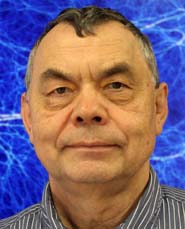KU physics professor receives Templeton Grant for study of cosmic complexity

Sergei Shandarin
LAWRENCE – Everyone looks up at the night sky and asks big questions. What is the structure of the universe, and is there more than one? What natural laws keep the cosmos in order? Where does it all begin, and does it have an end?
One of the scientists seeking answers to these seemingly infinite questions is Sergei Shandarin, a professor of physics and astronomy at the University of Kansas. During the next two years, his research will be supported by a prestigious $300,000 grant announced recently by the private John Templeton Foundation, part of a broader $5.6 million award to the University of Chicago.
The overall project, New Frontiers in Astronomy & Cosmology, involves 20 scientists from the U.S. and other countries, as well as 21 high school and college student essayists worldwide. Shandarin's grant is for a research project titled "The Emergence of Complex Structural Patterns: A Manifestation of Increasing Cosmic Complexity." He is joined by co-investigator Rien van de Weygaert, a professor of astronomy at the Kapteyn Astronomical Institute at the University of Groningen in The Netherlands.
Shandarin will travel to Philadelphia this week to present his winning proposal at a conference sponsored by the Templeton Foundation, whose goal is to "address four big questions that have potential to expand the boundaries and deepen the foundation of scientific inquiry:
• What was the earliest state of the universe?
• Is our universe unique or is it part of a much larger universe?
• What is the origin of the complexity in the universe?
• Are we alone in the universe? Or, are there other life and intelligence beyond the solar system?
Shandarin's project falls under the third category. He plans to explore the origin of the complexity in the universe by quantifying the structural growth of the universe itself.
"Ultimately, all structure in the universe is the result of the gravitational forces whose origin lies in the very first moments of the Big Bang," said Shandarin. "The role of gravity in this molding of the rich and complex patterns found in the universe will be the central focus of this project. Pattern formations of galaxies and stars will be studied in great detail, not only in ordinary three-dimensional space but also in the six-dimensional phase space."
He added that "the project is based on the realization that it is at these large scales that one may hope to unravel the gravitationally propelled mechanisms that are the agents behind the continuing proliferation of complexity in the cosmos."
Shandarin came to KU 1991 from the P.L. Kapitza Institute for Physical Problems, Russian Academy of Sciences. He previously spent 12 years as a junior research fellow at the Keldysh Institute of Applied Mathematics, Russian Academy of Sciences. His academic background includes a doctorate from the Moscow Institute of Physics and Technology (supervised by the internationally known physicist Yakov B. Zeldovich) and a senior doctorate from the Lomonosov Moscow State University.
KU is encouraging faculty to seek funding from private foundations in support of their research. The Office of Research and Graduate Studies created a position to support such grant proposals, and Becca Peterson was named director of research collaborations earlier this year. She worked with Shandarin to identify and pursue the Templeton Foundation award.